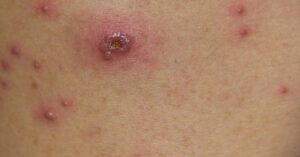What is Monkeypox?

Monkeypox is a rare viral disease that most commonly affects people living in rural areas of Africa. The Monkeypox virus is related to the viruses that cause chickenpox and smallpox.
There are two types of monkeypox: West African monkeypox and Central African monkey pox. West African monkeypox is more common and less severe than Central African monkeypox. Central African monkey pox is more severe and can be fatal.
History of Monkeypox:
Monkeypox was first identified in Monkey River, Liberia in 1958. The first human outbreak of the disease occurred in 1970 in the Democratic Republic of Congo. Between 1981 and 1986, there were Monkeypox outbreaks reported in Sudan, South Africa, Nigeria and other countries. The largest Monkeypox outbreak occurred in the Democratic Republic of Congo between 1996 and 1997, when more than 500 people were infected with the virus.
In the United States, there was a monkeypox outbreak In 2003. This is thought to have been caused by exposure to infected prairie dogs. There have been no Monkeypox outbreaks reported since then.
There have been several outbreaks of monkeypox reported in Africa. The most recent outbreak occurred in the Democratic Republic of Congo (DRC) in 2018, with over 100 cases being reported.
Monkeypox is most commonly found in rural Africa, where it is thought to be spread by contact with infected animals, such as rodents or primates. The disease can also be spread from person to person through close contact, such as caring for someone who is sick or sharing bedding or clothing with someone who has the disease.
Monkey pox generally affects children more than adults, and can be fatal in up to 20% of cases. However, with proper treatment, the mortality rate can be reduced to less than Monkeypox is most commonly found in rural Africa, where it is thought to be spread by contact with infected animals, such as rodents or primates. The disease can also be spread from person to person through close contact, such as caring for someone who is sick or sharing bedding or clothing with someone who has the disease.
2022 Monkeypox Outbreak:
The most recent outbreak of monkeypox began in may 2022 and has affected more than 80 people in 12 countries, including the United States, Canada, and Australia. The World Health Organization has said that another 50 suspected cases are being investigated and warned that more cases are likely to be reported.
The symptoms of Monkey Pox and How It Affects Daily Life:
The symptoms of monkeypox include fever, headache, muscle aches, fatigue, swollen lymph nodes, and a rash. Monkeypox can be mild or severe. In severe cases, Monkey pox can lead to pneumonia, encephalitis (inflammation of the brain), and death.
Monkeypox can be a serious illness, particularly for young children and people with weak immune systems. However, most people who contract the disease will recover within a few weeks with no lasting effects. Monkeypox can affect or impact on our daily lifestyle Healthcare, Social, Economy if it will not controllable.
Treatment Options for Monkeypox:
There is no specific treatment for Monkeypox, but the symptoms can be treated. Treatment focuses on relieving symptoms and supporting the respiratory and immune systems.
Patients with Monkeypox are usually treated in hospital isolation wards. They are given supportive care to relieve symptoms, including fever control and pain relief. Antibiotics may be given to prevent subsequent bacterial infections. In severe cases, patients may require intensive care and mechanical ventilation.
There is currently no vaccine available for Monkeypox. However, smallpox vaccines have been shown to be effective in preventing or reducing the severity of Monkeypox infection. The World Health Organization (WHO) recommends that people who have been exposed to Monkeypox should receive smallpox vaccination within three days of exposure.
How To Prevent Monkeypox Infection:
The best way to prevent monkeypox infection is to avoid exposure to the virus. This can be done by avoiding contact with infected animals, such as monkeys, and avoiding contact with people who have the disease. Monkeypox can also be prevented by vaccinating against smallpox. The smallpox vaccine is not 100% effective, but it can provide some protection against Monkeypox.
You can also reduce your risk of Monkeypox infection by washing your hands often and avoiding close contact with people who are sick. If you do come into contact with someone who has Monkeypox, you should see a doctor immediately.
Conclusion :What is Monkeypox?
Monkeypox is a rare viral disease that can be deadly, but most people who contract it will recover with no lasting effects. The best way to prevent Monkeypox is to avoid exposure to the virus by avoiding contact with infected animals and people. There is no specific treatment for Monkeypox, but the symptoms can be treated. If you think you have been exposed to Monkeypox, you should see a doctor immediately.
FAQs
Q: What are the symptoms of Monkeypox?
A: The symptoms of Monkeypox include fever, headache, muscle aches, backache, swollen lymph nodes, chills, and fatigue. A rash can also develop on the face, chest and body. The rash starts as small red bumps that turn into blisters filled with pus. Monkeypox can be deadly in some cases, but most people will recover with no lasting effects.
Q: How is Monkeypox spread?
A: Monkeypox is usually spread through contact with the infected animals or through contact with people who have the disease. It can also be spread by coming into contact with contaminated objects, such as bedding or clothing.
Q: Can Monkeypox be prevented?
A: Monkeypox can be prevented by avoiding exposure to the virus. This can be done by avoiding contact with infected animals, such as monkeys, and avoiding contact with people who have the disease. Monkeypox can also be prevented by vaccinating against smallpox.
Q: How is Monkeypox treated?
A: There no specific treatment for Monkeypox, but the symptoms can be treated. Treatment focuses on relieving the symptoms supporting the patient’s recovery. Bed rest, fluids, and pain relief medication can help relieve the symptoms of Monkeypox. In severe cases, hospitalization may be necessary.
Q: What is the most recent Monkeypox outbreak?
A: The most recent outbreak began in May 2022 and has affected more than 80 people in 12 countries, including the United States, Canada, and Australia. The World Health Organization has said that another 50 suspected cases are being investigated and warned that more cases are likely to be reported.






